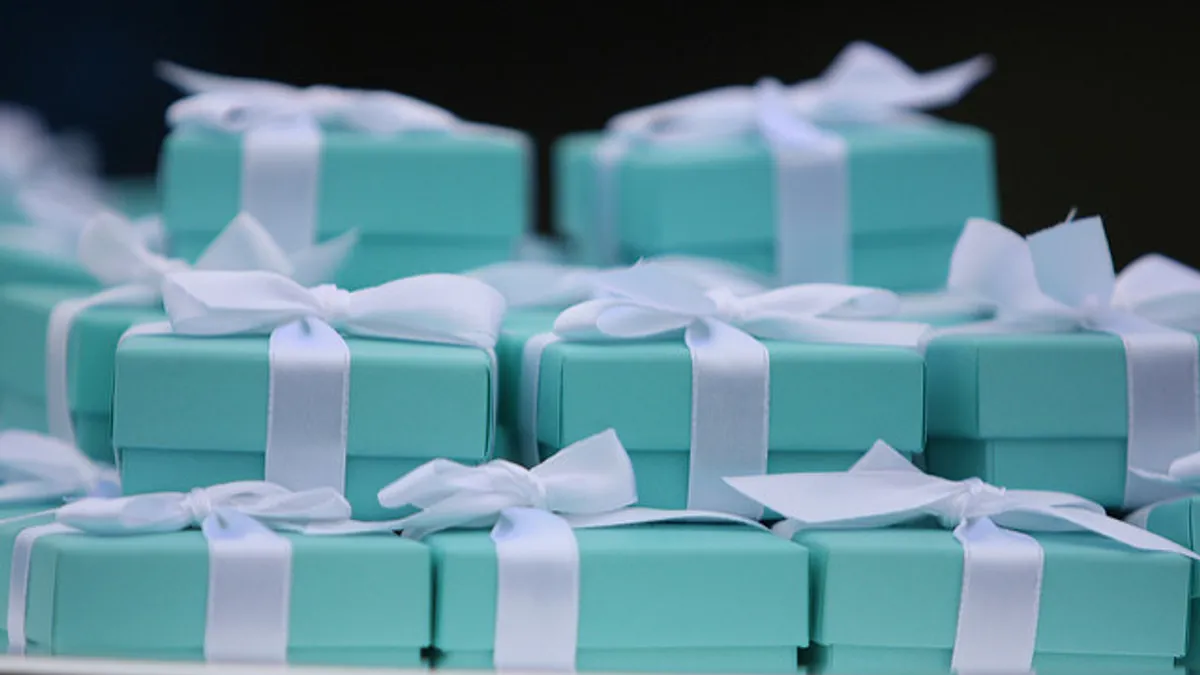Dive Brief:
-
Tiffany & Co. on Wednesday reported that "higher spending by local customers in all regions," (partly offset by lower spending by foreign, primarily Chinese tourists, in some areas) pushed third quarter global net sales up 4% (5% in constant currency) to $1 billion. Store comps rose 3%, according to a company press release.
-
Net earnings in the quarter fell 5% to $95 million, from $100 million a year ago, the company also said. Net inventories as of Oct. 31 were up 6% from a year ago.
-
Gross margins (gross profit as a percentage of net sales) rose to 62.2% in the quarter from the prior year's 61.5%, according to the release. That largely reflected favorable product input costs, lower wholesale sales of diamonds and leverage on fixed costs in the year-to-date, partly offset by more investments and a charge recorded in the third quarter of $8.5 million for estimated net losses from the recent bankruptcy filing of a precious metals refiner.
Dive Insight:
Tiffany has been working on a turnaround in an effort to draw in younger customers, and it's had favorable economic conditions to help it along.
In fact, its "plan has accelerated," according to a note from Jane Hali & Associates analysts. "We continue to see improvements across their marketing, social media, in-store experience and product." Jane Hali analysts noted particular interest in the company's HardWear and Paper Flowers lines. The company in a press release confirmed that the global launch of Paper Flowers is complete, and is resonating globally. In the quarter, the jeweler released Tiffany True, its first new engagement ring design in almost a decade and the first one designed by Reed Krakoff, according to Jane Hali analysts, who noted that the company attributes a quarter of its annual sales to wedding jewelry. Those designs have been "a critical part of Tiffany's transformation," according to a note from GlobalData Retail Managing Director Neil Saunders emailed to Retail Dive.
In Asia, where the company had to beat tough comparisons from last year's quarter, sales growth slowed to 4% (6% in constant currency). "[U]nderwhelming sales in this region are of particular note," William Blair analyst Dylan Carden warned in a note emailed to Retail Dive, considering the company's reliance on sales from Chinese consumers. The company in its release emphasized that local spending in mainland China remained strong, while weaker from Chinese tourists in the U.S. and Hong Kong.
But the company's sales in the U.S. in the quarter were otherwise especially good, rising 5%, which can be attributed in part to "the strength of the economy, with the increased affluence and confidence of middle and higher income consumers helping to boost spending on jewelry," according to Saunders. "However, much is also down to the revival of the Tiffany brand which is now resonating much more strongly among a number of key consumer groups."
That includes the company's current target, millennial shoppers. GlobalData research finds that brand recognition and affinity has risen "particularly sharply" among consumers 35 years old and under. "A few years ago, this group was largely apathetic to Tiffany, viewing the brand as old-fashioned and irrelevant to their needs and tastes," Saunders said. "In a relatively short space of time, Tiffany has started to shift that perception and demonstrate that it has something fresh to offer to younger consumers."
In a statement on Wednesday, Alessandro Bogliolo shrugged off macro headwinds. "Our full year outlook is unchanged," he said. "We believe we have substantial growth opportunities to pursue as a geographically-diversified luxury brand and are not distracted by external factors, such as the negative effects of a strong U.S. dollar or fluctuations in tourist spending."
The company's marketing is being amplified on social media with the help of influencers like Elle Fanning, A$AP Ferg, Maddie Ziegler, Yara Shahidi and Kendall Jenner with their own strong followings, Jane Hali noted. The company's Instagram followers have risen to 9.3 million from 8.8 million in August and 8.4 million in May, those analysts said.
So far this year Tiffany has opened nine company-operated stores and closed three, the company also said. As of Oct. 31, the company operated 321 stores versus 315 stores a year ago. "The experience in-store is improving and becoming much younger," Jane Hali said. "In our recent visit to some of their stores we noted the reflection of their recent campaigns within the store."
Saunders also hailed the jeweler's attention to what have been "fusty" stores and said that ongoing renovations, including one planned for its Fifth Avenue flagship, are promising despite their expense. "The work will be extensive and costly," he said. "It is a bold move that, in our opinion, underscores Tiffany's new found confidence."












